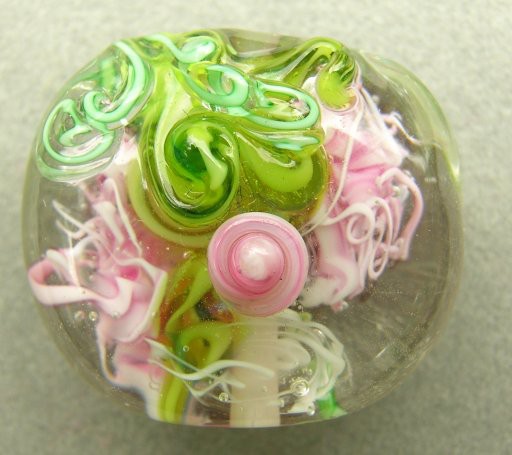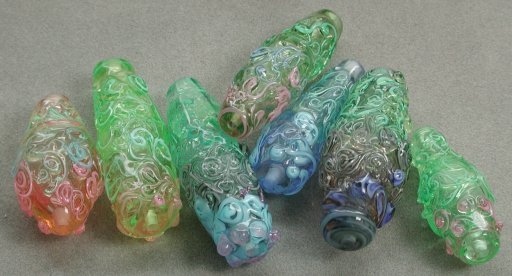One of the glass first beads I ever collected (as opposed to merely purchasing) was this lovely floral tabular by Patti Lorenz, which brings me to another favorite semi-rant: there seems to be a consensus out there that the more people learn to make glass beads, the worse it is for the ones already out there—at least in terms of marketing.
Certainly inexpensive, reasonably well-executed (if unimaginatively designed) Chinese lampwork beads are making it more difficult for beadmakers with a whole 3 weeks on the torch aspiring to sell their masterpieces. And it stands to reason that as the pool of lampwork beadmakers ramps up from 30 to 70,000 (these are numbers I heard from Kate Drew-Wilkerson, and I make no claims whatsoever for their accuracy, but there are unquestionably more beadmakers than there were when she started some three decades ago) that there will be more competition for shop and gallery owners’ dollars.
But here's the thing: until I started making beads, no way would I have spent $24 (which is what I recall paying for this bead and what I then considered a princely sum) for a glass bead. I simply couldn't justify it. Once I started making beads, however, then I was willing to start paying money for my peers’ work: because I could appreciate it, because it was inspirational, because it could teach me something (this last remains favorite rationalization).
So it is with this bead. I still love it (and incidentally the artist now makes this style in hollows) and on several occasions its freeform interpretation of the classic Venetian rose design has inspired me to something similar:
And I've been buying art glass beads ever since. I think once the quantity of glass beadmakers gets into the 5–6 figure range, most of those folks are going to pursue it at a hobby level: the barriers to entry are low enough nowadays people can try it on a whim. More power to them, for if you don't try a lot of different media, how can you determine which is to be your passion?
But even minimal experience teaches respect, and familiarity means a higher level of comfort. Having some other glass beadmaker beatcha to[o] the local beadstore owner's quarterly budget the week before is frustrating; but the real competition is all those other crafts out there—popular as beads have gotten, there are still far more yarn stores than beadstores. The more people interested in beads, the bigger the interest, the greater the diversity, the more opportunities there are for everyone.
About my efforts, which I don't feel match Lorenz's: I've made this basic style of bead intermittantly; this latest go-round is perhaps the 2nd or 3rd iteration. What I especially like about this last batch is ‘catching’ the edge of an older trailing with a stringer and raking it along in the new curl. Glass (and possibly other viscous media) lend itself to this, whereas ink wouldn't. Slow-drying paint might work, but the cool thing about the glass is the nearby curls soften and become available for raking simply by proximity to the flame melting the stringer.
I liked these beads well enough, but soon stopped making them; but the catch-the-edge of a stringer with raking curls is something I've happily added to other styles of beads. —I think I did these to use up a bunch of filigrana stringer (as opposed to the fancy ribbed stringer I now typically use in my florals) as anything else; some of the stringer is hand made, like the slate blue.
Knowledge (and experimentation) is never wasted.
Unless otherwise noted, text, image and objects depicted therein copyright 1996--present sylvus tarn.
Sylvus Tarn
